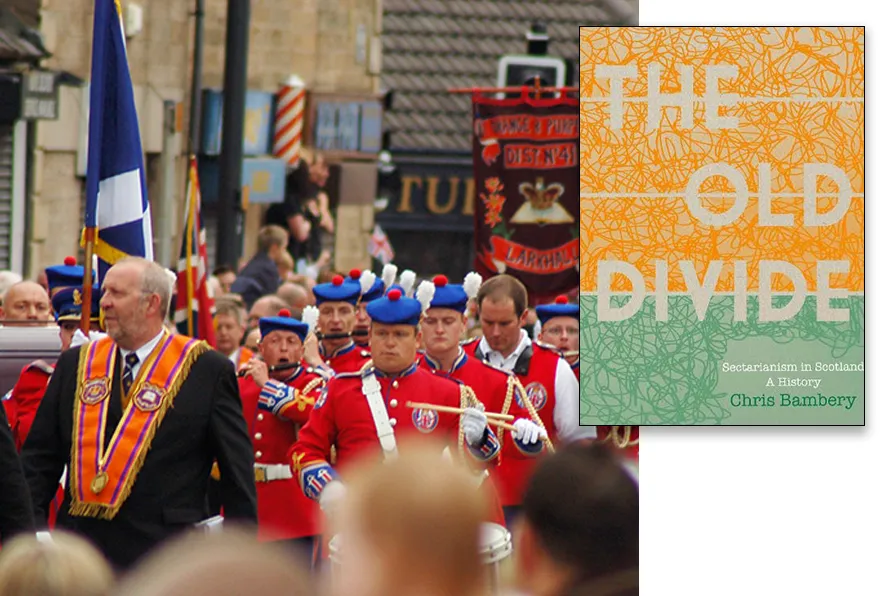GEOFF BOTTOMS appreciates the local touch brought to a production of Dickens’s perennial classic
JOHN McINALLY welcomes a rigorous class analysis of the history and exploitation of sectarianism by the Scottish ruling elite

 DIVISIVE SECTARIANISM: Orange Parade in Larkhall, Scotland, July 2008 [Pic: Ross Goodman/CC]
DIVISIVE SECTARIANISM: Orange Parade in Larkhall, Scotland, July 2008 [Pic: Ross Goodman/CC]
The Old Divide
Chris Bamberry, Tippermuir Books, £11.99
CHRIS BAMBERRY’s book, The Old Divide, asserts that sectarianism in Scotland is rooted in anti-Irish racism and arose from its “involvement in the subjugation of Ireland and in the construction of the British empire,” is essentially political rather than religious and, was driven from the “top down,” not upwards from the “lower classes.”
This rigorous class analysis explores Irish immigration to Scotland from the 18th century onwards, the role of the Orange Order, the “Fenian Scare”, opposition to Gladstone’s Home Rule Bills, Liberal Unionism and the revival of the Conservatives into an avowedly Unionist party, the exploitation of sectarian division by the Scottish elite, the influence of the churches, and a sober assessment of the role of the labour and trade union movement.
Social, economic and political factors influencing the development of sectarianism in Scotland are addressed, including their inter-connections; in their similarities and differences between Scotland and the Northern Irish Six County state; the demise of the old Scottish industrial employer elite; the creation of a Catholic middle class; and how middle-class elements purged emergent Scottish nationalism of its radicalism in favour of Scottish “identity” within the British state and empire.
The accusation “Catholicism leads to communism” reflected the elite’s fear that the struggle for Irish independence and the rise of industrial and political working-class militancy represented a mortal threat to the British capitalist unitary state and its imperial interests.
The 1926 General Strike provoked accusations that “in the industrial areas nearly all the leaders were Irish” and “in the course of time instead of a Scottish proletariat there would be a body of people who had no regard for the United Kingdom and who were prone to revolutionary ideas.”
Irish immigrants were blamed for the election of the “Red Clydeside” MPs in 1922 and the rise of industrial militancy, but neither would have been possible without significant numbers of “loyal, Protestant” workers voting and striking in their class interest. Periods of intense class struggle produced solidarity, acting as a brake on sectarian sentiment, but when the labour and trade union movement was in retreat, it intensified, as in the 1930s.
Parallels with contemporary anti-immigration racism are unavoidable. A minister at the 1922 General Assembly of the Church of Scotland proclaimed: “Roman Catholics of Irish origin… were not only alien to Scots in religion; they were also alien in race. They had come to Scotland to take jobs from Scottish workers, to exploit Scotland’s welfare resources and to stir labour unions… Irish Catholic men were also seducing innocent Scottish girls into mixed marriages ‘to betray the faith of their fathers’.”
The presence of the Irish Catholic aliens, he prophesied, would soon bring racial and sectarian warfare to Scotland.
The reactionary role of the Catholic Church is touched upon; urging its flock to vote Labour but acting as a bulwark against militancy and socialist ideas, its “presence acting within it as a purifying force.”
The current rebranding of Orange Walks, of which there are more in Glasgow than Belfast, as colourful cultural “traditions” is rightly exposed. Those of us who grew up with “Up to our knees in Fenian blood” ringing in our ears knew these expressions of “loyalist” Protestant supremacy represented divisive sectarianism in its rawest form.
The self-satisfied liberal Scottish middle-class establishment, now embracing identity politics, conveniently forget their antecedents’ role in building the British empire while falsely, and complacently, insisting that today sectarianism resides solely amongst the “Neds”, ie lumpen working-class youth.
The 2014 independence referendum saw the Orange Order attempt to exploit the old prejudices to secure the Union. In current conditions of extended reaction, with the national question unresolved in Scotland and Ireland, any resurgence of demands for independence, especially alongside working-class militancy, may well see sectarianism revived and weaponised by Farage’s Reform, and even the British state.
For its explanation of the class basis for sectarianism and racism alone, this is a book for our times.










